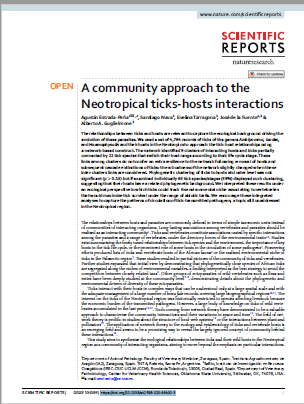Ver ítem
- xmlui.general.dspace_homeCentros Regionales y EEAsCentro Regional Santa FeEEA RafaelaArtículos científicosxmlui.ArtifactBrowser.ItemViewer.trail
- Inicio
- Centros Regionales y EEAs
- Centro Regional Santa Fe
- EEA Rafaela
- Artículos científicos
- Ver ítem
A community approach to the Neotropical ticks-hosts interactions
Resumen
The relationships between ticks and hosts are relevant to capture the ecological background driving the evolution of these parasites. We used a set of 4,764 records of ticks of the genera Amblyomma, Ixodes, and Haemaphysalis and their hosts in the Neotropics to approach the tick-host relationships using a network-based construct. The network identified 9 clusters of interacting hosts and ticks partially connected by 22 tick species that switch their host
[ver mas...]
The relationships between ticks and hosts are relevant to capture the ecological background driving the evolution of these parasites. We used a set of 4,764 records of ticks of the genera Amblyomma, Ixodes, and Haemaphysalis and their hosts in the Neotropics to approach the tick-host relationships using a network-based construct. The network identified 9 clusters of interacting hosts and ticks partially connected by 22 tick species that switch their host range according to their life cycle stage. These links among clusters do not confer an extra resilience to the network following removal of hosts and subsequent cascade extinctions of ticks: the robustness of the network slightly changed when these inter-clusters links are considered. Phylogenetic clustering of ticks to hosts at cluster level was not significant (p > 0.15) but if examined individually 63 tick species/stages (59%) displayed such clustering, suggesting that their hosts have a related phylogenetic background. We interpreted these results under an ecological perspective in which ticks could track its environmental niche associating to vertebrates that would maximize tick survival under the range of abiotic traits. We encourage these integrated analyses to capture the patterns of circulation of tick-transmitted pathogens, a topic still unaddressed in the Neotropical region.
[Cerrar]

Autor
Estrada-Peña, Agustín;
Nava Santiago;
Tarragona Evelina Luisa;
de la Fuente, José;
Guglielmone Alberto;
Fuente
Scientific reports 10 : 9269. (2020)
Fecha
2020-06-09
Editorial
Springer Nature
ISSN
2045-2322 (Online)
Formato
pdf
Tipo de documento
artículo
Palabras Claves
Derechos de acceso
Abierto
 Excepto donde se diga explicitamente, este item se publica bajo la siguiente descripción: Creative Commons Attribution-NonCommercial-ShareAlike 2.5 Unported (CC BY-NC-SA 2.5)
Excepto donde se diga explicitamente, este item se publica bajo la siguiente descripción: Creative Commons Attribution-NonCommercial-ShareAlike 2.5 Unported (CC BY-NC-SA 2.5)


